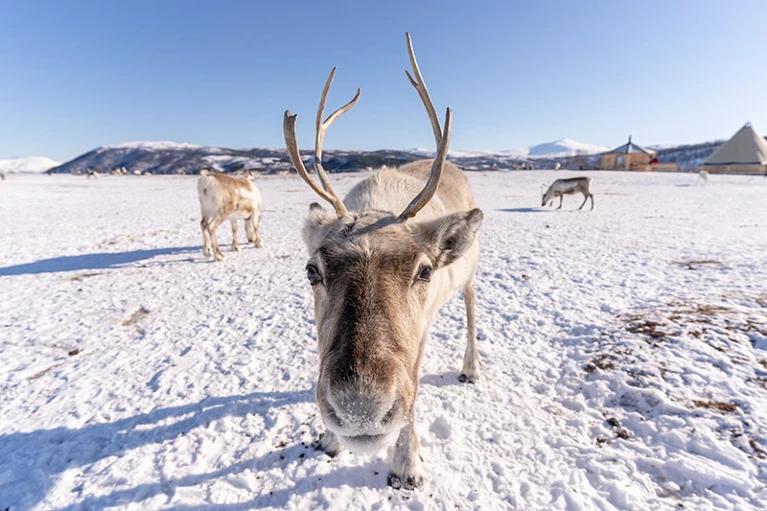Arctic multitasking: sleeping while eating
Reindeer in the Arctic need to be well equipped to survive the harsh winters. Eating, however, is still as important as always. Since reindeer are herbivores, it takes quite some time to gather the nutrients needed to keep their body functioning properly and be kept warm. A new study found that in order to do this, reindeer have a special ‘mode’ while eating: sleep-mode. They can put their brain in a sleep-like state so they can maximize their eating time. Researchers from the University of Zurich found that during rumination (storing grass in a stomach chamber for later chewing), reindeer brains show patterns associated with non-REM sleep. They don’t close their eyes, but sit and stand quietly and produce less noise in general, as if they’re sleepwalking. Moreover, the more they did this, the less actual sleep they needed resulting in the ultimate multitasking.
Dramatic blobs in the Earth’s mantle
Blobs in the Earth’s mantle. Mysterious formations of thousand kilometers long and denser than their surroundings. It might not seem that interesting, but they have a dramatic origin story. The two blobs are remnants of a giant collision that happened about 4.5 billion years ago. This should sound familiar since it’s thought this is the same collision that formed the Moon. Modeling shows that material from the colliding planet, Theia, embedded itself in the Earth’s mantle (while some of it was flung into orbit to form the Moon). The material slowly sank to the bottom of the Earth’s mantle and started piling up, forming the blobs we observe today, 4.5 billion years later. It is hypothesized that these blobs compose the bulk of what it is also known as ULVZs and that most hotspots we have on earth are in some way feeded by these blobs.

Wagging left and right: a dog’s communication tool
A dog wagging their tail, most of us probably think this means the dog is happy or excited, but studies show this is only the tip of the iceberg: a dog’s tail may represent an entire language. Dogs, like other animals, use their tail for a number of reasons. Canids use their tail especially for communication (think about a scared dog having their tail tucked between their legs), but while wagging is uncommon in wolves, domestic dogs wag their tail at any occasion. One hypothesis is that during the domestication process, humans mainly selected dogs that wagged their tails a lot because of our attraction to rhythmic stimuli. Another hypothesis is that the genes linked to tail wagging were genetically linked to traits like docility and tameness. No matter the origin, a dog’s tail can say a lot about its mental state. The carriage and speed make the difference between “I’m happy to see you” or “I’m going to attack you”, but wagging to the left or right also changes its meaning. If the dog encounters something it wants to approach, the tail wags to the right, if it wants to avoid it, it wags to the left. Dogs can even perceive those asymmetries in other dogs and will respond differently based on the wagging they observe, similar to how humans can read face and body language.
Ancient modern urbanism
The ancient Amazonian jungle, thick rainforest as an inhospitable place. Sparsely populated, right? Actually, this was not the case. Enormous cities were discovered over the last twenty years which show us the southern American continent was home to complex societies long before European colonizers took over. Recently, remains of another society were found. The dense network of interconnected cities found in Ecuador is the oldest ever found in the area. This network of at least 2500 years old (1000 years older than any other known Amazonian society) was found using laser mapping technology, called lidar, which allows researchers to see through the thick rainforest cover. This discovery highlights the long-unrecognized diversity of ancient Amazonian cultures. A vast network of 15 settlements across 300 square kilometers show us their way of living. The cities were interspersed with agricultural fields, surrounded by terraces and connected by wide, straight roads with streets between houses and neighborhoods. Modern urbanism, a complexity now found already 2500 years ago.
Credit Featured Image: Henry Lo/500px via Getty
Credit In Text Image: Hernán Cañellas





